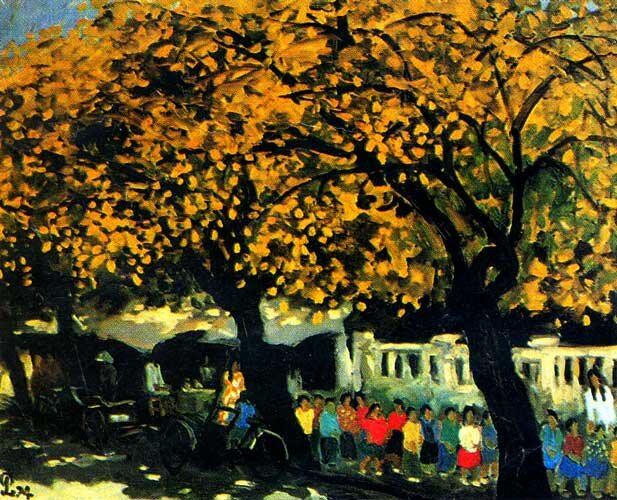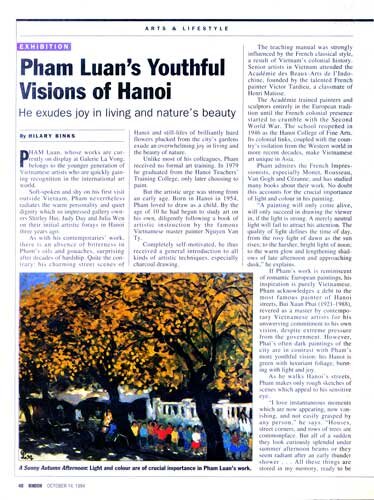Pham Luan's Youthful Visions of Hanoi
by Hilary Binks
A Sunny Autumn Afternoon. 1994
He exudes joy in living and nature’s beauty.
Pham Luan, whose works are currently on display at Galerie La Vong, belongs to the younger generation of Vietnamese artists who are quickly gaining recognition in the international art world.
Soft-spoken and shy on his first visit outside Vietnam, Pham nevertheless radiates the warm personality and quiet dignity which so impressed gallery owners Shirley Hui, Judy Day and Julia Wen on their initial artistic forays in Hanoi three years ago.
As with his contemporaries’ work, there is an absence of bitterness in Pham’s oils and gouaches, surprising after decades of hardship. Quite the contrary: His charming street scenes of Hanoi and still-lifes of brilliantly hued flowers plucked from the city’s gardens exude an overwhelming joy in living and the beauty of nature.
Unlike most of his colleagues, Pham received no formal art training. In 1979 he graduated from the Hanoi Teachers’ Training College, only later choosing to paint.
But the artistic urge was strong from an early age. Born in Hanoi in 1954, Pham loved to draw as a child. By the age of 10 he had begun to study art on his own, diligently following a book of artistic instruction by the famous Vietnamese master painter Nguyen Van Ty.
Completely self-motivated, he thus received a general introduction to all kinds of artistic techniques, especially charcoal drawing.
The teaching manual was strongly influenced by the French classical style, a result of Vietnam’s colonial history. Senior artists in Vietnam attended the Académie des Beaux-Arts de l’Indochine, founded by the talented French painter Victor Tardieu, a classmate of Henri Matisse.
The Académie trained painters and sculptors entirely in the European tradition until the French colonial presence started to crumble with the Second World War. The school reopened in 1946 as the Hanoi College of Fine Arts. Its colonial links, coupled with the country’s isolation from the Western world is more recent decades, make Vietnamese art unique in Asia.
Pham admires the French Impressionists, especially Monet, Rousseau, Van Gogh and Cézanne, and has studied many books about their work. No doubt this accounts for the crucial importance of light and colour in his painting.
“A painting will only come alive, will only succeed in drawing the viewer in, if the light is strong. A merely neutral light will fail to attract his attention. The quality of light defines the time of day, from the rosy light of dawn as the sun rises; to the harsher, bright light of noon; to the warm glow and lengthening shadows of late afternoon and approaching dusk,” he explains.
If Pham’s work is reminiscent of romantic European paintings, his inspiration is purely Vietnamese. Pham acknowledges a debt to the most famous painter of Hanoi streets, Bui Xuan Phai (1921-1988), revered as a master by contemporary Vietnamese artists for his unswerving commitment to his own vision, despite extreme pressure from the government. However, Phai’s often dark paintings of the city are in contrast with Pham’s more youthful vision: his Hanoi is green with luxuriant foliage, bursting with light and joy.
As he walks Hanoi’s streets, Pham makes only rough sketches of scenes which appeal to his sensitive eye.
“I love instantaneous moments which are now appearing, now vanishing, and not easily grasped by any person,” he says. “Houses, street corners, and rows of trees are commonplace. But all of a sudden they look curiously splendid under summer afternoon beams or they seem radiant after an early thunder shower…All these things are stored in my memory, ready to be recreated later in my paintings.”
In The Morning, three beautiful young girls in virginal white dresses are riding bicycles beneath blossom-laden trees beside a lake. The location, Pham explains, is Lake Tay, a popular place for Hanoi’s courting couples, and the name of the road is Thanh Nien Bu, or “Road of Youth.”
The gallery’s Judy Day comments: “Many of his paintings depict a scene which is almost ideal. This is the kind of day we would all like to be riding a bicycle down this street. You can sense that the air is fresh and clean, that it’s early morning and you have a wonderful day ahead of you. That is the way his paintings make you feel.”
Though Pham was brought up in a classical Vietnamese household, he readily admits that at heart he is a romantic. His aim is for all his work to be beautiful, positive, optimistic; he has no wish to portray sadness or despair. He is also totally dedicated to his work.
“Any artistic work, whether it is realistic or abstract,” he writes, “should imply the genuine emotion of its author. The heart, the mind, the view, and the hands of the artist must be in perfect harmony…Yet emotion alone is deficient without creativeness and hard work.”
Pham paints alone in his studio, but in the true French tradition enjoys meeting artist friends in Hanoi cafés and galleries to drink coffee and exchange ideas with them as well as with writers, musicians, film-makers, poets and others.
Pham has had two one-man shows so far: one in 1991, the second at Hanoi’s Exhibition House in January this year. He has also participated in several group shows winning awards at the Hanoi Fine Arts Exhibition in 1990, 1991 and 1993. Bringing the artist to Hong Kong is consistent with Galerie La Vong’s stated aim of representing the finest contemporary painters in Vietnam and continuing to seek outstanding creative talent.


